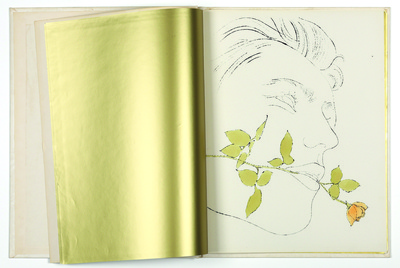Warhol by the Book

Andy Warhol, A Gold Book, 1957, ©The Andy Warhol Foundation for the Visual Arts, Inc. Courtesy of The Andy Warhol Museum, Pittsburgh.
Before he became a pop art icon, Andy Warhol illustrated book jackets. He also designed books and published and collected them. In many ways, books informed his entire career, a significance only now being recognized as art scholars plumb the depths of his vast work.
Warhol By The Book, an exhibition of more than 400 objects, is the first to examine the full range of his book projects. A collaboration with Andy Warhol Museum in Pittsburgh, it heralds what may be a wave of Warhol exhibitions at American colleges and universities that benefited from the Andy Warhol Foundation’s recent decision to distribute its Warhol collection.
Warhol by the Book features published and unpublished projects, source materials, photos, news clippings, videos, pages from the artist’s diaries and even a reconstruction of his reading library. Arranged chronologically over six galleries, it is so dense with visuals, texts and cross-references as to be mind-numbing. Viewers who stick with it, however, will come away with a truer sense of Warhol’s inventive genius, a creative authenticity often overshadowed by his bizarre appearance, personality and celebrity-studded lifestyle he cultivated.
Warhol was among the first to wrap a jacket illustration around the entire book and create cover-design patterns with rubber stamps.
His line drawings—particularly for children’s books—are whimsical and charming, made more so by the texts hand written by his mother, Julia Warhola, one of his many collaborators.
Although he did not invent the pop-up, accordion or portfolio book formats, he pushed them into radical new territory, inserting removable objects into one pop-up prototype and creating an accordion book with unreadable abstract illustrations and no words. His oversize portfolio on President Kennedy’s assassination, made up of neon-colored news-source images and a teletype-style text, is a visual stunner. Warhol used the tools of mass communication—digital prints, Polaroid photos, videos, inked press plates and even proof notes and out-of-register images—to establish a signature visual language that reflected the pervasive consumerism of late 20th century culture. For him, the medium truly was the message.
